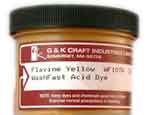What colors can I dye my green Cordura nylon?
Name: Dean
—ADVERTISEMENT—
Washfast Acid dyes
at Paradise Fibers

Washfast Acid dyes
Also known as Nylomine dyes, excellent for use on nylon. One ounce of dye will dye six pounds of fiber!
at Paradise Fibers

Washfast Acid dyes
Also known as Nylomine dyes, excellent for use on nylon. One ounce of dye will dye six pounds of fiber!
Message: I need to dye some cordura nylon. It's green, I followed your instructions on how to do it properly. But my question is, what colors can I use to dye green what colors? i.e. red n green make brown and such. I'm not sure what colors I want just know I don't want greem. What are my choices, if you know? Thanks for all your time.
A fun way to explore color combinations is to use Olli Niemitalo's Dye Mixer Applet. Select one or two colors and adjust the slider bars until you have a close approximation of the color you have, then try adding other colors on another line. It's a great way to think about color mixing without the mess of actually doing it with dyes, so it can save you a lot of time.
As you already realize, the color you have already will show through any color of dye you use, because dye is transparent. You will not be able to get red, yellow, or blue by overdyeing something that is green. Green plus yellow makes a slightly yellower green. Green plus blue makes aqua. Green plus navy blue makes a greenish navy. Green plus a bright orange makes brown. Green plus red makes a brownish black. Green plus purple can make black, too, depending on the relative shades you start with. Black will be the easiest color other than green for you to obtain, by overdyeing with a lot of black dye, or with dark reds.
If you don't want black or brown, you might be able to remove some or all of the green in your cordura nylon by heating it with a dye removing chemical. Do not ever use chlorine bleach, which contains hypochlorite, on nylon, as it will be severely damaged. There are other dye removing chemicals that are safe to use with nylon, however. The easiest of these to obtain is called Rit Color Remover. It can be found in most grocery stores and pharmacies in the US, next to the packages of Rit dye. It is an excellent product, safer to use than household bleach. Use with care, following the instructions. Be sure to use good ventilation, and take particular care to avoid exposure to the fumes if you have asthma; you can use a face mask respirator with acid gas cartridges. (See "What chemicals can be used to remove dye?".)
The biggest problem in dyeing nylon is that sometimes the nylon is coated with a water-repellent finish, which will repel dye, preventing dyeing from working at all well. Even non-water-repellent nylon may contain oils or waxes from the spinning or weaving process which will interfere with dyeing; sometimes washing in hot water with detergent will remove them, but many times it will not. If you are lucky enough to have nylon which has no substances on it to interfere with dyeing, you can easily dye it by heating it with an acid dye. Dyeing nylon works best if you add some acid. The makers of Tintex all-purpose dye, which like all dyes labeled all-purpose, contains some acid dye, recommend adding 100 ml (7 tablespoons) of distilled white vinegar per gallon of water in the dyebath. Vinegar is of no use at all in dyeing cotton, but it is very useful in dyeing nylon.
(Please help support this web site. Thank you.)
Posted: Saturday - February 21, 2009 at 10:00 PM
Follow this blog on twitter here.
Quick Links
- All About Dyes & Dyeing Top -
- Top of this blog -
- FAQ -
- The Dye Forum -
- How to Tie Dye - How to Batik -
- Books - Toys - Plants -
- Top of this blog -
- FAQ -
- The Dye Forum -
- How to Tie Dye - How to Batik -
- Books - Toys - Plants -
More in this category:
- -
Statistics
Total entries in this blog:
Total entries in this category:
Published On: Aug 29, 2012 02:48 PM
Total entries in this category:
Published On: Aug 29, 2012 02:48 PM